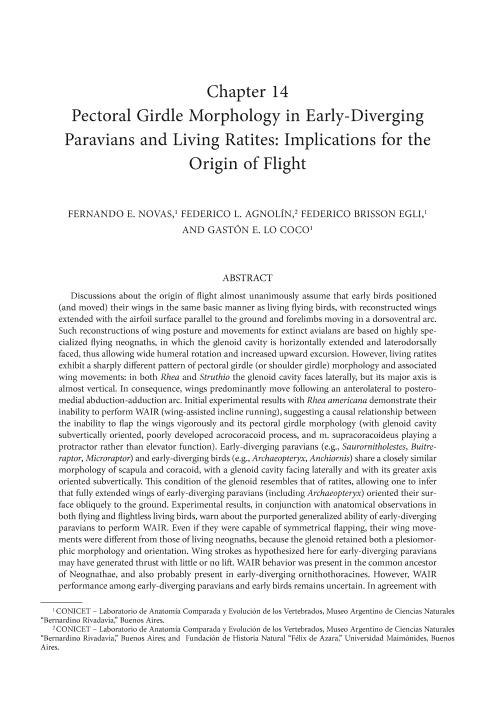Artículo
Pectoral Girdle Morphology in Early-Diverging Paravians and Living Ratites: Implications for the Origin of Flight
Fecha de publicación:
08/2020
Editorial:
American Museum of Natural History
Revista:
Bulletin of the American Museum of Natural History
ISSN:
0003-0090
Idioma:
Inglés
Tipo de recurso:
Artículo publicado
Clasificación temática:
Resumen
Discussions about the origin of flight almost unanimously assume that early birds positioned (and moved) their wings in the same basic manner as living flying birds, with reconstructed wings extended with the airfoil surface parallel to the ground and forelimbs moving in a dorsoventral arc. Such reconstructions of wing posture and movements for extinct avialans are based on highly specialized flying neognaths, in which the glenoid cavity is horizontally extended and laterodorsally faced, thus allowing wide humeral rotation and increased upward excursion. However, living ratites exhibit a sharply different pattern of pectoral girdle (or shoulder girdle) morphology and associated wing movements: in both Rhea and Struthio the glenoid cavity faces laterally, but its major axis is almost vertical. In consequence, wings predominantly move following an anterolateral to posteromedial abduction-adduction arc. Initial experimental results with Rhea americana demonstrate their inability to perform WAIR (wing-assisted incline running), suggesting a causal relationship between the inability to flap the wings vigorously and its pectoral girdle morphology (with glenoid cavity subvertically oriented, poorly developed acrocoracoid process, and m. supracoracoideus playing a protractor rather than elevator function). Early-diverging paravians (e.g., Saurornitholestes, Buitreraptor, Microraptor) and early-diverging birds (e.g., Archaeopteryx, Anchiornis) share a closely similar morphology of scapula and coracoid, with a glenoid cavity facing laterally and with its greater axis oriented subvertically. This condition of the glenoid resembles that of ratites, allowing one to infer that fully extended wings of early-diverging paravians (including Archaeopteryx) oriented their surface obliquely to the ground. Experimental results, in conjunction with anatomical observations in both flying and flightless living birds, warn about the purported generalized ability of early-diverging paravians to perform WAIR. Even if they were capable of symmetrical flapping, their wing movements were different from those of living neognaths, because the glenoid retained both a plesiomorphic morphology and orientation. Wing strokes as hypothesized here for early-diverging paravians may have generated thrust with little or no lift. WAIR behavior was present in the common ancestor of Neognathae, and also probably present in early-diverging ornithothoracines. However, WAIR performance among early-diverging paravians and early birds remains uncertain. In agreement with recent contributions, we conclude that the origin of flapping flight (and eventually WAIR) emerged in birds that diverged later than Archaeopteryx, with the acquisition of a horizontally placed major glenoid axis, which allowed wider dorsoventral forelimb excursions.
Palabras clave:
ORIGIN OF FLIGHT
,
PARAVIANS
,
EARLY BIRDS
,
RATITES
,
PECTORAL GIRDLE
Archivos asociados
Licencia
Identificadores
Colecciones
Articulos(MACNBR)
Articulos de MUSEO ARG.DE CS.NAT "BERNARDINO RIVADAVIA"
Articulos de MUSEO ARG.DE CS.NAT "BERNARDINO RIVADAVIA"
Citación
Novas, Fernando Emilio; Agnolin, Federico; Brissón Egli, Federico; Lo Coco, Gastón Ernesto; Pectoral Girdle Morphology in Early-Diverging Paravians and Living Ratites: Implications for the Origin of Flight; American Museum of Natural History; Bulletin of the American Museum of Natural History; 440; 1; 8-2020; 345-353
Compartir




